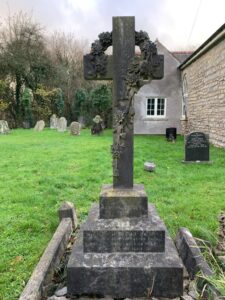William Watkins
A Significant figure in Nash
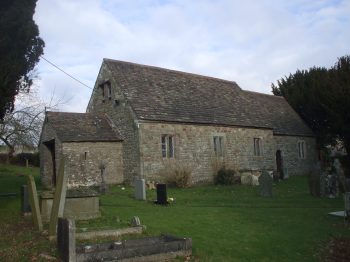
William Watkins was our 2nd great-grandfather. He was the son of Thomas Watkins (b. 1790), a native of Christchurch, Newport, and Rachel Jones (b. 1789). William’s parents had married in 1816 at St Tegfedd Church in Llandegveth, a small country church dating to the 12th century. They first lived in Christchurch before moving to Llantarnam, where five of their children, including William, were born.
They had seven children in all: Rachel 1818, Ann 1820, Thomas 1822, William 1824, David 1828, Henry 1830, and John 1835. The baptism records for all children were Nonconformist. These were records kept by non-Anglican churches or other congregations that recorded details of people who did not belong to the Church of England.
On the 1841 census Thomas and Rachel were living in Llandegveth, a village in Monmouthshire sitting, between Cwmbran in Torfaen and Usk in Monmouthshire, with their seven children. The children’s ages ranged from 7-23 and Thomas was listed on the census as a farmer. During the 1840s the family made a move to Whitson on the Gwent Levels, where Thomas took on a 114-acre farm. Three children remained at home, Rachel, William, and John.
It was whilst living in Whitson that 30-year-old William, our 2nd great-grandfather, married Ann Baker. The service took place on the 25th April 1854, at the parish church in St Brides. His father Thomas was able to attend the wedding but died 11 months later on 17th March 1855. He is buried at the Holy Trinity Church, Christchurch in a significant grave located close to the church entrance.
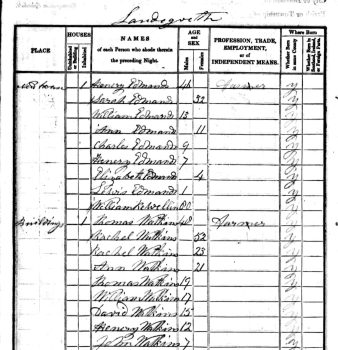
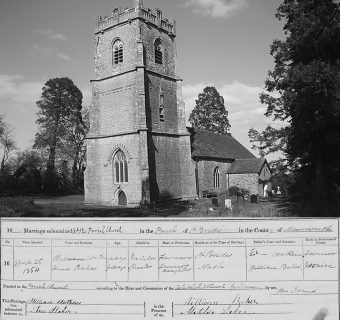
William’s new wife Ann had been born in 1828, she was the daughter of a famer from Goldcliff. She was one of ten children and lost both of her parents at a young age. By 1851 at the age of 23, she was listed as head of household and living with her siblings at Pye Corner in Nash.
After their marriage William and Ann settled at Pye Corner Farm, in Nash, where William farmed the 111 acres and was able to purchase the property. Census returns show William and Ann spent 40 years at Pye Corner. The farm was Grade II listed in 1996 as farmhouse typical of the Gwent Levels. As of 2024 the farmhouse exterior has been fully restored and is waiting for work on the interior.
William and Ann had 9 children, all baptised at Nash Baptist Church. William was first in 1855, followed by Eliza 1857, Matilda 1859, Herbert 1861, Frederick 1863, Selina 1865, Rosa (our great-grandmother)1867, George 1870 and finally Myra in 1873. The chapel is located 100 yards from Pye Corner Farm and played host to Watkins family christenings, weddings, and funerals.
The chapel opened in 1820 with seats for 125. However, in 1889 a Baptist church opened in nearby Lliswerry and a decline in attendances started. By the 1980s the worshippers at Nash Baptist Chapel fell to only 5 and the church was closed. The graveyard soon became overgrown but is now once again in good order and the chapel has been converted to a private residence.
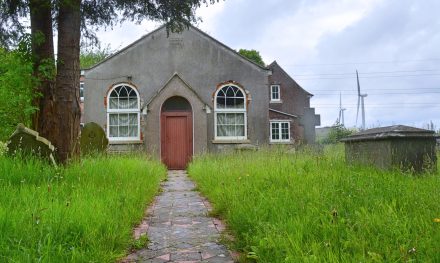
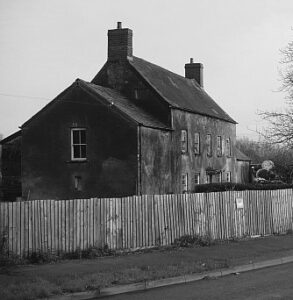
William Watkins made a real success of Pye Corner Farm. Numerous newspaper reports talk of awards won for cattle including the Town Cup for his Heifers, whilst his beef, pork and dairy was sold far and wide. He also become a powerful man in Nash, he stood unopposed as a local councillor and also became a parish overseer. This involved organising the collection of taxes and ensuring rules and regulations were followed.
William Watkins’ life in Nash was not incident free. In 1877 he made the paper in a headline called ‘The farmer and his servant’. His farm labourer, Thomas Jones, was accused of attacking William after a dispute. The labourer claimed self-defence saying that Wiliam had raised a staff above his head, but the court were not convinced. Jones was convicted by the court and sentenced to keep the peace for a month and pay the costs.
In 1884 William was back in court with his fellow overseer for Nash, Thomas Waters. They had failed to pay a call for £77 due to the Christchurch Highway Board on 1tth June and a distress warrant was issued by the court. The two blamed the error on their junior officers which the court accepted and they were discharged.
William maintained a close-relationship with his widowed-mother Rachel. After the loss of her husband, she had lived with William’s brother David in Christchurch, before in the 1870s returning to Pye Corner. In 1881 Rachel Watkins aged 92, was living on independent means at Rose Cottage in Pye Corner, a short walk from William. Rose was assisted by Fanny Price, a domestic servant, and was recorded as the oldest person in Nash. She died in March 1883.
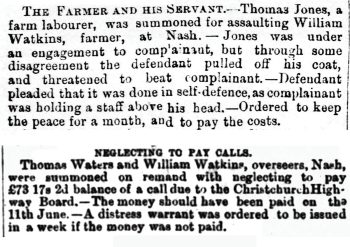
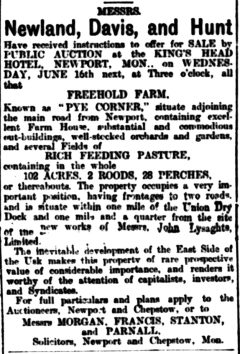
By the 1891 census William and Ann were still living at Pye Corner Farm, with their three youngest children, Rosa, George, and Myra. Selina had tragically died in 1882 aged 17 and the other five children had left home. Work on the farm was now on a reduced scale with just one full time worker, William Danish, living on the farm and assisting William and George.
Ann Watkins died on 22nd November 1896 and was buried at Nash Baptist Chapel. William then decided to sell Pye Corner Farm. On the 28th May 1887 the freehold of the farm was advertised for public auction in June at the King’s Head Hotel. The advert, aimed at investors, mentioned the excellent farmhouse, well stocked orchards and more than 100 acres of rich feeding pasture.
William died in 1889 aged 75, less than 2 years after the sale of his farm. He was buried with his late wife. The grave reads: ‘In loving memory of Ann. Beloved wife of William Watkins who died at Pye Corner, Nash 22 November 1896. Aged 68 years. Her end was peace. Also, of William late of Pye Corner. Who died 24th April 1899. Aged 75 years. Prepare to meet thy god’.
The success Wiliam achieved in his life led to a healthy estate for his children and put them on a path to success. At least four of his surviving children, William, Rosa, George, and Myra became landowners in their own right. Whilst William and George followed in their father’s footsteps and became successful farmers.
